You are reading the older HTML site
Positive Feedback ISSUE
14
july/august 2004
purist audio designs
Musaeus interconnect, speaker and AC cables
as reviewed by Vade Forrester

VADE FORRESTER'S SYSTEM LOUDSPEAKERS ELECTRONICS SOURCES CABLES ACCESSORIES
|
When PFO Editor Dave Clark offered me the opportunity to review the Musaeus interconnects, speaker cables, and power cords from Purist Audio Design, I realized that I couldn't even pronounce their name! Fortunately, Purist's gracious CEO and founder, Jim Aud, took pity on my ignorance and informed me that it is pronounced "Mew-say-us," and that Musaeus was the mythical founder of the Greek mysteries and a mystical singer allied with Orpheus.
Several years ago, I auditioned some Purist interconnects that were cushioned by a fluid layer inside their jackets. Although they sounded easily as good as any of the cables I had at the time, their stiffness meant that they would not work in my antique equipment cabinet. I expected the Musaeus cables to be similarly stiff, but I was surprised and delighted to find that although they are quite thick and heavy, they are very flexible. Actually, the word "limp" came to mind.
I was curious about their construction technique, so I consulted the Purist Audio website, which told me: "Introduced in 2002, the Musaeus is one of two revolutionary new cables in which Purist Audio Design's trademark fluid shield is replaced by an even more advanced shielding material that we call Ferox. This RF conductive compound, with a consistency much like sand, lowers the noise floor more than any other Purist technology. The affordable Musaeus opens the door to an entirely new range of music dynamics and a singular experience with sound." Jim Aud describes Ferox as "a doped silicon-based granular material, with superior proprieties of EMI and RF rejection, and excellent vibration rejection characteristics."
Aside from Ferox, the Musaeus cables feature one other technological advance worth mentioning, a treatment called Cryomag. Cryogenic treatment of hi-fi cables is almost standard these days—I know of one manufacturer who cryo-ed an entire amplifier!—but Purist augments cryo treatment with a "proprietary process in which the cables are subjected to lower temperatures in a controlled magnetic field; the ultimate goal being to align the crystal structure of the materials."
The power cords appear to be very well constructed. I didn't recognize the power and IEC plugs, but they seemed sturdy, and they made very positive contact with my FIM wall plug and various IEC connectors. Their relatively light weight kept them from falling out of the IEC jacks, which can be a problem with heavier power cords. The power cords are the only Musaeus cables that don't use the Ferox shielding. Figure 1 shows how the power cord is constructed, while Figure 2 shows how it looks (it's the one on the lower right):
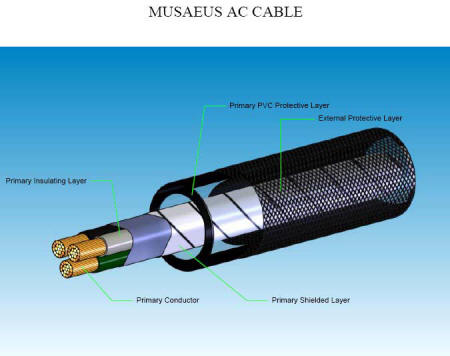
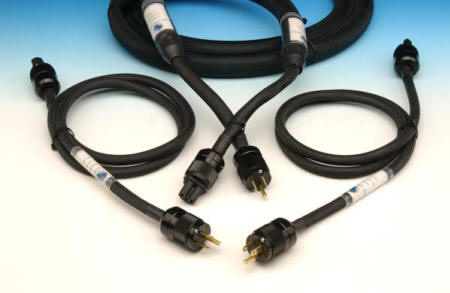
-
Conductor: Stranded, multi-gauge alloy
-
Metals: Copper
-
Shielding: Aluminized foil layer
-
Dielectric material: Polyvinyl Chloride
-
Gauge (effective): 14 AWG
-
Current capacity (DC): 15 A @ 75°C
-
Resistance: 8.596 mΩ /m per conductor
-
Break-in time: 75 hours
-
Cable diameter (nominal): 1/2" OD
-
Material treatment: Cryomag©
The speaker cables are the thickest of the Musaeus cables, and they are heavy! There is obviously a lot of Ferox in the jackets. Figure 3 shows the construction of the speaker cables, while Figure 4 shows the finished product:
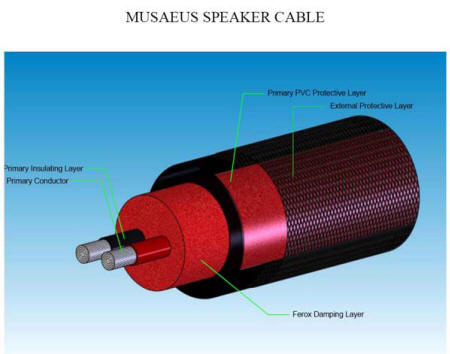
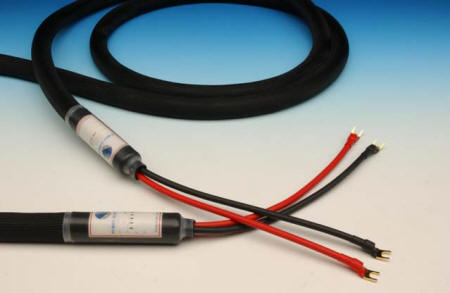
-
Conductor: Stranded, multi-gauge alloy
-
Metals; Copper, silver
-
Shielding; Ferox
-
Dielectric material: Teflon©
-
Gauge (effective): 10 AWG
-
Current capacity (DC): 27 A @ 200°C
-
Resistance: 4.29 mΩ /m per conductor
-
Break-in time: 120 hours
-
Cable diameter (nominal): 3/4" OD (one channel)
-
Material treatment: Cryomag©
The cable ends were terminated to my order with gold-plated spades on both the amplifier and speaker ends. Directionality was clearly marked via a large label on each cable, but right and left cables were distinguished only by the border color of these labels. This is not a problem, just something to be aware of. Did I mention that these cables are heavy?
The Musaeus interconnects were terminated with proprietary RCA plugs (XLR and other terminations are also available). Jim Aud explained that some customers had experienced problems with locking plugs damaging jacks when they forgot to unlock them before disconnecting them. Sounds like something I would do! The Purist RCAs look pretty ordinary, but never failed to provide firm connection to the wide variety of jacks. This is particularly important when a cable weighs as much as the Musaeus, as it can put extra stress on a connection or even pull the plug out of a jack. Figure 5 shows the construction of the interconnect cables, while Figure 6 shows the finished product (second from top):
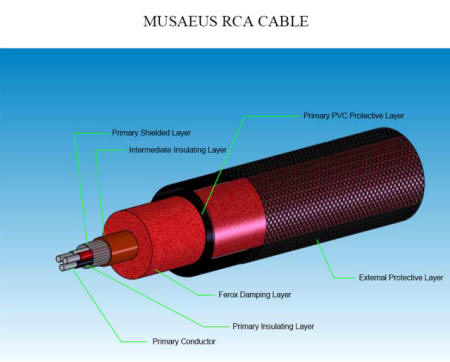
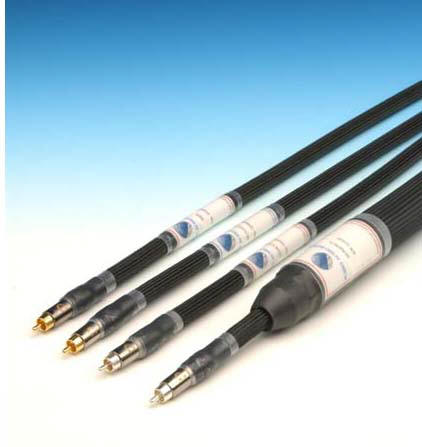
-
Conductor: Stranded, multi-gauge alloy
-
Metals: Copper, silver, gold
-
Shielding: Polyester wrap, braided silver-plated copper with 90% coverage, FEROX
-
Dielectric material: Teflon©
-
Gauge (effective): 20 AWG
-
Capacitance: 220 pF/m ±15% (pin-to-shield)
-
Resistance: 43.12 mΩ/m (conductor)
-
Break-in time: 110 hours
-
Cable diameter (nominal): 1/2" OD (one channel)
-
Material treatment: Cryomag©
All of the Musaeus cables appear to be very well made. The shrinkwrap was easily the best I've seen. Perhaps that's irrelevant, but perhaps it indicates how meticulously the cables are assembled. I decided to forego the destructive disassembly that would tell me that for sure.
I particularly appreciated the fact that break-in times were specified for each cable, especially since they seemed to be correct. Jim Aud sent one of his excellent System Enhancer CDs to help with break-in, and I installed the cables in a secondary system and played the break-in CD for 120 hours, the longest break-in time specified. The power cables were broken in by connecting them to 100-watt lamps via Chris Venhaus' IEC adapters. I exercised a little discipline for once, and resisted the temptation to listen to the cables before they were fully broken in, although I sneaked in a couple of preview sessions to be sure that the process was working. It was. The cables initially sounded zingy, with emphasized highs and lows, but as the break-in proceeded, the sound became more balanced. I resisted all temptations to listen critically during the break-in period. Perhaps I'm actually becoming mature, not just old.
Most cable manufacturers claim that there's a synergistic voicing to be gained from using their cables throughout a system, so that's how I evaluated the Musaeus cables. I used a one-meter and a two-meter pair of interconnects, two six-foot power cords, and an eight-foot pair of speaker cables. The power cords fed the power amp and the CD player, and the interconnects connected CD player to preamp and preamp to power amp. Of course, the speaker cables went where speaker cables go—from the amp to the speakers. Since I will make some inevitable and some implied comparisons between my normal cables and the Musaeus cables, I'll list my cables:
-
CD to preamp: DNM interconnects with Eichmann bullet plugs
-
Preamp to amp: PS Audio xStream Statement interconnects
-
Speaker cables: Blue Marble Audio
-
Power cables: Blue Marble Audio
The first thing I noticed was that the Musaeus cables were spookily quiet. This was not subtle. As a result, they produced lots of musically relevant detail, but didn't fake it by exaggerating the high frequencies. They passed a lot of information through the system to the speakers unmasked by noise from outside vibration or electrical interference. Reviewers often talk about a black background in which notes emerge from total silence. Obviously, cables play a part in creating this effect.
I'm a big fan of music from the Renaissance and Baroque eras, especially when it's played on period instruments or replicas of period instruments. One of the earliest groups to play period instruments was the Canadian chamber group Tafelmusik. On their CD Popular Masterworks of the Baroque, recorded by Keith Johnson for Reference Recordings (RR-13), the Musaeus cables brought out the unique timbre of this group's instruments, so perfectly suited to the music written for them. I've listened to this CD many times, but the instrumental color through the Musaeus cables was the most accurate that I've heard. Every piece on the CD had plenty of forward momentum, indicating good pace, rhythm, and timing. I had a strong urge to get up and dance to the jaunty baroque music, but fortunately for my dignity, I resisted the urge.
Jazz aficionados may look askance at Kenny G, but since I'm not really a jazz fan, I can admit I like his album Breathless (Arista 18646-2). It has some pretty tunes and is well recorded. On the track "Forever in Love," the sax tone was gorgeous, and the microdynamics made for a truly realistic impression of a small jazz combo. The rhythmic pace was again strong. The soundstaging of the Musaeus cables was another manifestation of their freedom from noise. Voices and instruments were extremely well defined in space, producing a strong impression of musicians performing in my room. Even the performers in larger groups, like symphony orchestras, were firmly located within the performance space. No, I couldn't hear reflections from the back wall of the stage, but I never can. I can't hear them in the concert hall, either.
One of my favorite CDs (actually an SACD) is Jennifer Warnes' The Well (Cisco Music SCD 2034). It's a very natural recording, not a hi-fi spectacular. "Prairie Melancholy" is a haunting song written from the viewpoint of a recently deceased lady. Through the Musaeus cables, it had strong, tuneful bass and very smooth overall sound. Even more impressive was the very open soundstage, with the musicians precisely located in space. During my first listen to this song, I realized that the quiet background offered by the Musaeus cables let me listen at lower levels without losing information—an effect my wife is certain to appreciate.
"The Panther," another song on The Well, begins with an interesting array of sounds, including some very high-frequency chimes. With some cables, the chimes seem to go on forever, with lots of interesting detail and interplay, but with the Musaeus cables, something was missing. I observed that the high frequencies were slightly rolled off, and the chimes didn't seem quite as tinkly as they do with some other cables. There was copious detail, so it was clear that the cables didn't depend on elevated high frequencies to create the illusion of detail. To verify my impression, I put on the CD Celtic Dreams (Dargason Music DMCD-107). Sure enough, Joemy Wilson's hammered dulcimer lacked the high-frequency extension I was used to hearing. The Musaeus cables emphasized the wooden body over the harmonics, making it sound like a different instrument.
Then I remembered my experience with the PS Audio xStream Statement interconnects. Their sound was somewhat similar to the Musaeus'—smooth, dynamic, and quiet—but they also rolled off the highs, in fact, much more so. My solution, made possible by a new equipment rack, was to scrap the two-meter interconnects between my preamp and amp and use a one-meter pair. That restored the high frequencies very satisfactorily. Would the same strategy work for the Musaeus cable? I connected the one-meter Musaeus pair between my preamp and amp, and a one-meter pair of the extremely neutral DNM cable between the CD player and preamp. Hoping for the best, I played "The Panther" again. Bingo! The tinkly highs were back. I believe this is due at least in part to the rather high output impedance of my Audio Note preamp, which interacts with cables of higher capacitance to roll off the high end. More modern preamps, either tube or solid state, would probably not exhibit the problem. Still, I have used several interconnects that exhibited more extended highs.
On Enya's Watermark (Reprise 9 26774-2), the song "The Long Ships" has a powerful bass drum, which can pressurize the room if the speakers can handle it. With the Musaeus cables feeding my ReTHM horn loudspeakers, the bass was surprisingly deep, though scarcely the equal of my subwoofer. The bass was also detailed, and clearly produced by someone whacking a humongous drum. Many other speakers produce more low bass energy on this track, but jumble the details so you can't distinguish the instrument.
The Musaeus cables were particularly well matched to my Art Audio amplifier, which tends to be a little forward. The combination provided a smooth, relaxed sound that made long-term listening very enjoyable. Often during the test period, the Musaeus-equipped system would be on all day, either in a primary listening mode or background music mode, during which the outstanding KPAC radio station provided enjoyable round-the-clock classical music. I don't always feel that way when listening to other cables, and sometimes look forward to turning the system off!
In summary, Purist Audio Design's Musaeus cables were extremely quiet, detailed without the slightest hint of peakiness, and ultra-smooth, with a robust, weighty low end and realistic dynamics. Their quietness produced unusually precise soundstaging. They made listening to music more enjoyable, and (cliché alert) frequently kept me up listening to music way past my bedtime. The Musaeus cables are superb, and are highly recommended. I've never heard my system sound better, or even as good. And remember, these are Purist Audio's economy cables. I can't imagine how anyone could make a cable that sounds significantly better. Vade Forrester
Musaeus cables
Interconnects with
Purist RCA plugs: 1 meter $299/pair, 2 meters $379/pair
Speaker cables: 8 feet
with spade lugs $495/pair
Power cords: 2 meters
$445
Purist Audio
Designs
TEL: 979. 265. 5114
web address:
www.puristaudiodesign.com
